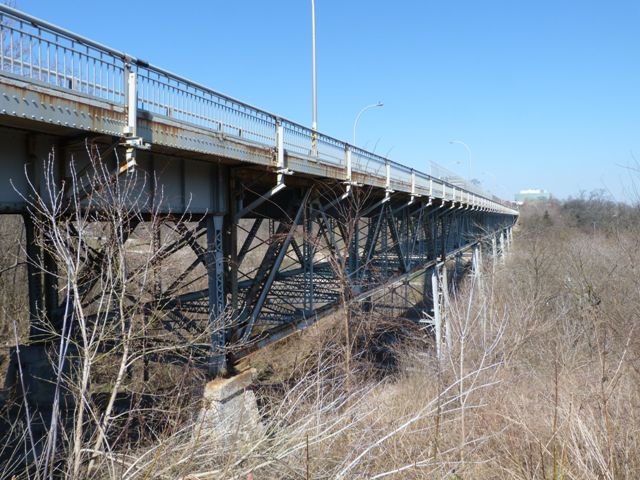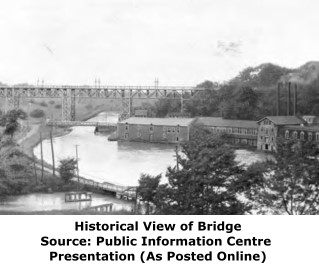We Recommend:
Bach Steel - Experts at historic truss bridge restoration.
BridgeHunter.com Phase 1 is released to the public! - Visit Now
Burgoyne Bridge
St. Paul Street Bridge

Primary Photographer(s): Nathan Holth
Bridge Documented: May 13, 2005 and March 20, 2012
St. Catharines: Niagara Region, Ontario: Canada
Metal 6 Panel Rivet-Connected Warren Deck Truss, Fixed and Approach Spans: Metal Deck Girder, Fixed
1915 By Builder/Contractor: Dominion Steel and Coal Corporation and Engineer/Design: Sprague and Reppert of Pittsburgh, Pennsylvania
Not Available or Not Applicable
120.0 Feet (36.6 Meters)
1,236.0 Feet (376.7 Meters)
30 Feet (9.14 Meters)
7 Main Span(s) and 5 Approach Span(s)
Not Applicable

View Information About HSR Ratings
Bridge Documentation
This bridge no longer exists!
This monumental heritage bridge was demolished and replaced!
View a historical article about this bridge.
View the heritage assessment for this bridge.

Located next to the beautiful St. Paul Crescent Bridge, this was a high-level bridge that cleared the entire river valley. It was an impressive structure, and a rare example of a high-level deck truss constructed for highway use in southern Ontario. Today all that remains is one bent. Scroll to the bottom of this narrative for a photo by Peter D.A. Warwick.
The bridge was built in 1915 by the Dominion Steel and Coal Corporation. It is a multi-span high-level Warren deck truss with riveted connections, and it is supported by steel bents. The steel bents and the truss spans are built of similarly composed built-up beams which give the bridge a uniform appearance. It passes over 12 Mile Creek, as well as the 406 expressway. It leads directly into the downtown area. The bridge's connections are riveted, and there is v-lacing and lattice on many built-up beams composing the truss members and bracing.
The bridge is historically and technologically significant as a large bridge that represents a significant engineering and construction effort, and is also a rare example of its structure type. Additional significance arises from the bridge's extremely high level of historic integrity. Even elements that are normally expected to be replaced over the service life of a bridge such as the deck stringers are original and unaltered. Even the metal panels that span between deck stringers and form the base for the deck appear to be riveted and thus are assumed to be original.
According to local news articles, the Niagara Region felt that the best way to deal with this landmark heritage bridge was to reduce it to a pile of scrap metal in a $40,000,000 demolition and replacement project that forever destroyed this beautiful heritage bridge and put in its place a structure with no heritage value whatsoever.
In contrast, the demolition of the Burgoyne Bridge resulted in the loss of a unique and important heritage bridge. Sadly, this is only a continuation of the strong downturn in remaining heritage bridges in Ontario that has occurred in recent years. The Niagara Region is of particular concern, since numerous heritage bridges have been demolished in recent years or are planned for demolition in the near future. Despite a history of maintaining Ontario's considerable wealth of heritage bridges in the past, when it comes time to consider a comprehensive rehabilitation of a heritage bridge that would extend the life of the heritage bridge for the foreseeable future, Ontario and the Niagara Region has not shown a commitment to preservation. Instead, perhaps taking a page from the wasteful (in terms of materials, money, and heritage) bridge policies and programs of the United States, the hasty and tragic decision is often made to demolish and replace the heritage bridge.
The bridge is named after a prominent area family best known for running the St. Catharines Standard newspaper for many years. Henry Burgoyne, the fourth generation of his family died in February 2011, right in the midst of the time where discussions on the future of the heritage bridge which bears his families name were ongoing.
Above: When the bridge was replaced, one of the bents was left standing as a sort of memorial of the destroyed heritage bridge. The bent is shown above. Photo Credit: Peter D.A. Warwick
![]()
Photo Galleries and Videos: Burgoyne Bridge
2012 Bridge Photo-Documentation
Original / Full Size PhotosA collection of overview and detail photos, taken March 20, 2012. This gallery offers photos in the highest available resolution and file size in a touch-friendly popup viewer.
Alternatively, Browse Without Using Viewer
![]()
2012 Bridge Photo-Documentation
Mobile Optimized PhotosA collection of overview and detail photos, taken March 20, 2012. This gallery features data-friendly, fast-loading photos in a touch-friendly popup viewer.
Alternatively, Browse Without Using Viewer
![]()
2005 Bridge Photo-Documentation
Original / Full Size PhotosA collection of overview and detail photos, taken May 13, 2005. This gallery offers photos in the highest available resolution and file size in a touch-friendly popup viewer.
Alternatively, Browse Without Using Viewer
![]()
2005 Bridge Photo-Documentation
Mobile Optimized PhotosA collection of overview and detail photos, taken May 13, 2005. This gallery features data-friendly, fast-loading photos in a touch-friendly popup viewer.
Alternatively, Browse Without Using Viewer
![]()
Replacement Bridge and Memorial Documentation
Original / Full Size PhotosA collection of overview and detail photos. This gallery offers photos in the highest available resolution and file size in a touch-friendly popup viewer.
Alternatively, Browse Without Using Viewer
![]()
Replacement Bridge and Memorial Documentation
Mobile Optimized PhotosA collection of overview and detail photos. This gallery features data-friendly, fast-loading photos in a touch-friendly popup viewer.
Alternatively, Browse Without Using Viewer
![]()
Maps and Links: Burgoyne Bridge
This historic bridge has been demolished. This map is shown for reference purposes only.
Coordinates (Latitude, Longitude):
Search For Additional Bridge Listings:
Additional Maps:
Google Streetview (If Available)
GeoHack (Additional Links and Coordinates)
Apple Maps (Via DuckDuckGo Search)
Apple Maps (Apple devices only)
Android: Open Location In Your Map or GPS App
Flickr Gallery (Find Nearby Photos)
Wikimedia Commons (Find Nearby Photos)
Directions Via Sygic For Android
Directions Via Sygic For iOS and Android Dolphin Browser










